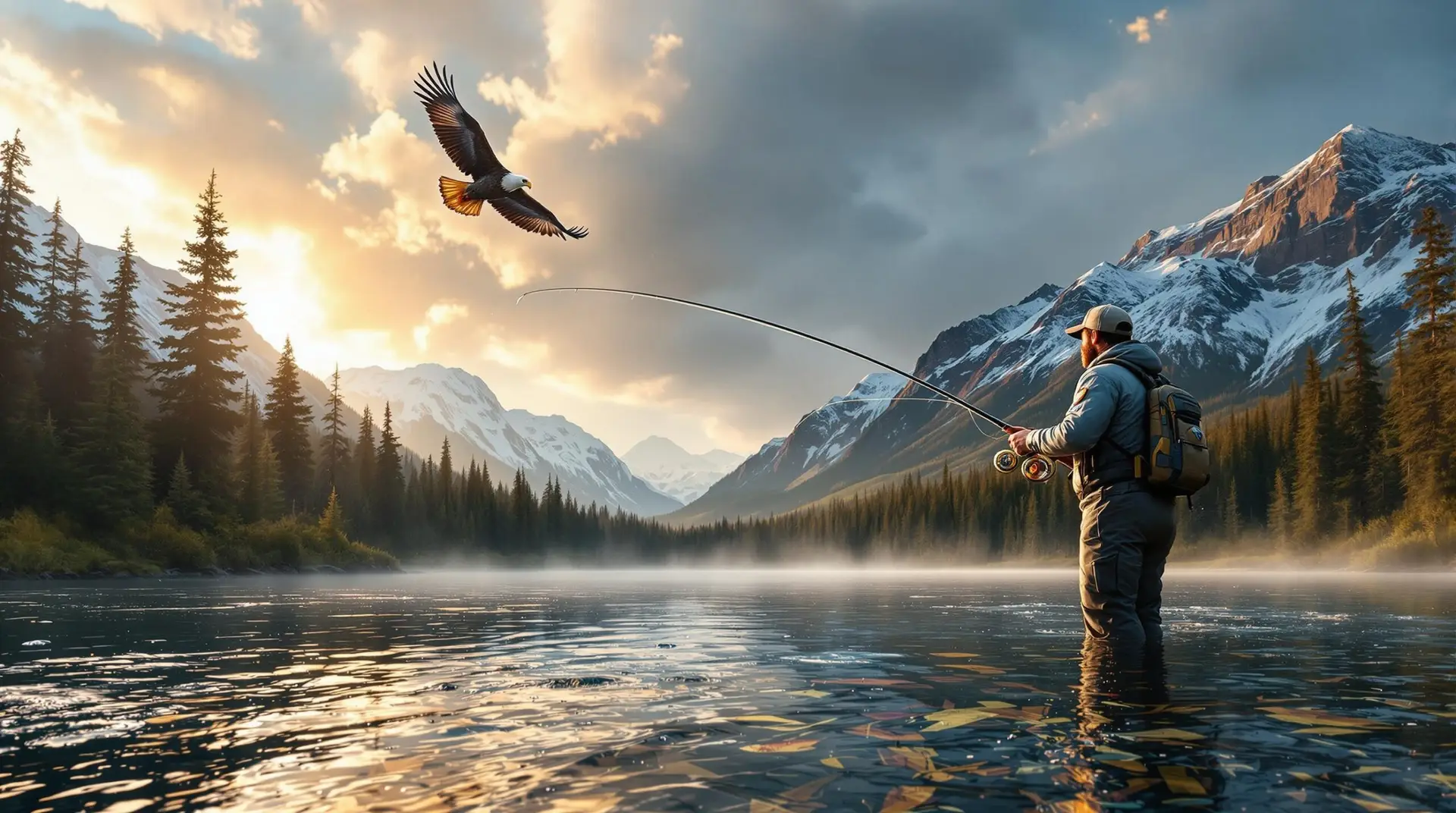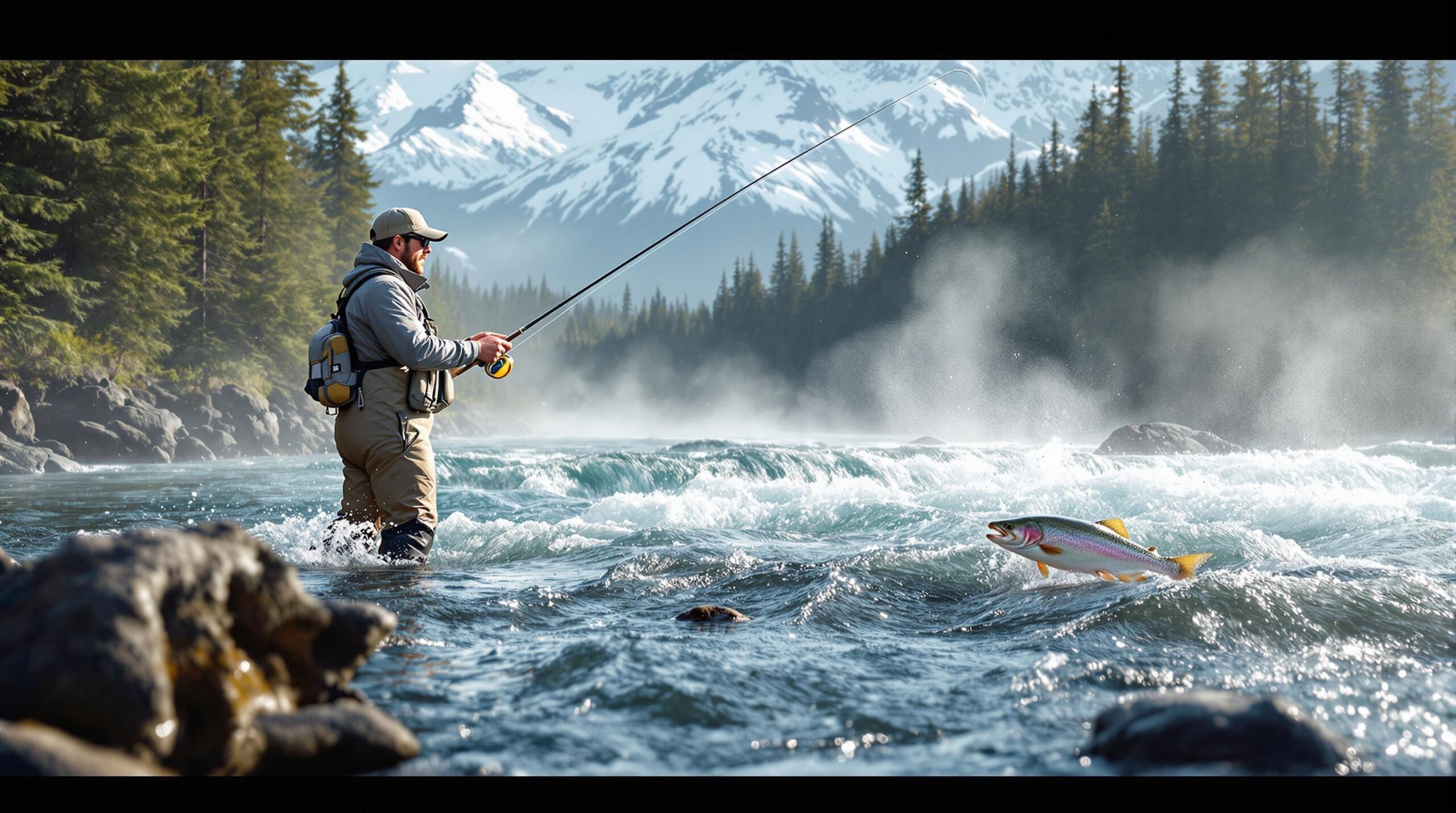10 Best Places to Go Fly Fishing in Alaska: The Ultimate Angler’s Guide
According to a 2021 report from the American Sportfishing Association, recreational fishing contributes an astounding $34.3 billion to the U.S. GDP annually, with Alaska representing one of the most coveted destinations for serious anglers. Fly fishing in Alaska offers unparalleled experiences in pristine wilderness settings, where anglers can target everything from massive king salmon to trophy rainbow trout across countless rivers, streams, and lakes that define the Last Frontier’s magnificent landscape.
Key Takeaways
- Alaska’s diverse ecosystems support multiple fish species including all five Pacific salmon varieties and trophy rainbow trout
- The best time for fly fishing in Alaska varies by species, with peak salmon runs occurring from May through October
- Remote locations like American Creek and Prince of Wales Island offer exceptional fly fishing opportunities accessible primarily by floatplane
- Proper gear selection is crucial, with 8-10 weight rods recommended for salmon and 5-7 weight rods for trout species
- Many guided services and fishing lodges provide expert instruction, quality equipment, and access to premier fishing locations
Why Alaska Reigns Supreme for Fly Fishing Enthusiasts
Alaska stands as the ultimate fly fishing destination for serious anglers worldwide. With over 3,000 rivers, 3 million lakes, and 6,640 miles of coastline, the opportunities for fly fishing in Alaska are virtually limitless. What separates Alaska from other fishing destinations is not just the quantity of waters but their quality – pristine, largely undeveloped watersheds teeming with fish that have never seen artificial flies.
The state’s unique geographical position creates ideal conditions for massive fish populations. According to research from the Institute of Social and Economic Research, Alaska saw a 25% increase in non-resident fishing licenses as anglers worldwide recognized the exceptional quality of fly fishing in Alaska. From the legendary Kenai River system to remote wilderness streams accessible only by floatplane, Alaska offers fly fishing experiences that simply cannot be replicated elsewhere.
Remote Wilderness Treasures for Fly Fishing in Alaska
American Creek: Katmai National Park’s Hidden Gem for Fly Fishing in Alaska
American Creek represents one of the most sought-after fly fishing destinations in Alaska’s vast wilderness. Located within Katmai National Park, this waterway is accessible only via floatplane, which immediately sets it apart as a premium fly fishing experience. According to Drifthook Fly Fishing, anglers typically access American Creek through operations like Crystal Creek Lodge, involving a breathtaking 20-minute flight that provides spectacular aerial views of Naknek and Grosvenor Lakes.
The creek’s legendary rainbow trout population makes it worth the journey. These fish, having evolved to feed on salmon eggs and flesh, grow to exceptional sizes. Strict catch-and-release practices ensure these magnificent specimens remain available for future anglers. For those planning to fly fish in Alaska at American Creek, recommended flies include:
- Prince of Wales (sizes 4-6)
- Beadhead Prince Nymphs (sizes 12-14)
- Muddler Minnows (sizes 6-8)
Prince of Wales Island: Southeast Alaska’s Fly Fishing Paradise
As the fourth-largest island in the United States, Prince of Wales Island offers exceptional diversity for fly fishing in Alaska. What makes this destination particularly appealing is the dual opportunity for both saltwater and freshwater fly fishing experiences. Boardwalk Lodge provides guided access to 23 lakes and rivers across the island, each offering unique fishing opportunities.
The species diversity here is remarkable, with anglers targeting halibut and rockfish in saltwater settings while pursuing salmon, steelhead, and cutthroat trout in freshwater environments. Prime seasons vary by species:
- King Salmon: May through July
- Coho Salmon: August through September
- Steelhead: April through May and again from September through October
For successful fly fishing in Alaska on Prince of Wales Island, anglers should pack Hare Ball Leeches (size 2), Dolly Llamas (size 2), and Clouser Minnows (sizes 2-6) to match the varied feeding preferences of the island’s diverse fish populations.
Legendary River Systems for Fly Fishing in Alaska
The Mighty Kenai: Trophy Salmon and Trout Haven
The Kenai River stands as perhaps the most iconic destination for fly fishing in Alaska, with a well-earned reputation for producing record-breaking king salmon exceeding 70 pounds. The lower Kenai River and the Kasilof River below Killey River represent prime locations for targeting these magnificent fish. Cooper Landing Fishing Guide services cover nearly 100 river miles, providing anglers with expert guidance across this legendary system.
Seasonal strategies are essential when planning a Kenai fly fishing expedition:
- May-June: Target king salmon using large streamers and egg patterns
- July-August: Switch to fluorescent flies for sockeye salmon runs
- September-October: Use baitfish imitations for silver salmon
For fly fishing in Alaska, the Kenai offers the opportunity to catch multiple species within a single trip, making it an excellent choice for anglers looking to experience the diversity of Alaska’s fishing seasons without traveling to multiple locations.
Additional World-Class Fly Fishing Rivers in Alaska
Beyond the Kenai, Alaska offers numerous world-class river systems for fly fishing enthusiasts. The Alagnak River in Bristol Bay features remarkable accessibility to all five Pacific salmon species, while the Kvichak River boasts some of the largest rainbow trout in the state. These destinations represent just a fraction of the premier fly fishing destinations available across Alaska’s vast landscape.
Many of these rivers benefit from conservation efforts that have preserved their natural qualities. When selecting a river for fly fishing in Alaska, anglers should consider factors including:
- Species preference (salmon, trout, char, grayling)
- Desired level of remoteness
- Physical accessibility requirements
- Budget considerations
Essential Gear for Successful Fly Fishing in Alaska
Rod, Reel and Line Selection for Fly Fishing in Alaska’s Diverse Waters
Selecting the appropriate gear is critical for successful fly fishing in Alaska. The diverse fish species require specialized equipment selections based on your target fish:
- 8-10 weight rods for salmon and steelhead
- 5-7 weight rods for trout and char species
- Medium to large arbor reels with reliable sealed drag systems
- Floating lines for surface presentations, sink-tip lines for deeper waters
Alaska’s unpredictable weather conditions make backup equipment essential. Packing spare rod sections, extra leaders, and multiple line options ensures you’ll remain prepared regardless of conditions encountered. Many Alaska fly fishing lodges provide quality equipment for guests, though serious anglers typically prefer using their own gear.
Must-Have Flies for Fly Fishing in Alaska
A well-stocked fly box is essential for fly fishing in Alaska. Different species and seasons demand specific fly patterns:
- Salmon patterns: Egg-sucking leeches, Alaskan Intruders, and Dolly Llamas
- Trout patterns: Sculpin imitations, egg patterns, and CDC caddis dry flies
- Saltwater selections: Deceivers and Clouser patterns for halibut and rockfish
Local fly shops provide valuable insights into current hatch conditions and can suggest region-specific patterns that may not be widely available elsewhere. When fly fishing in Alaska, it’s advisable to carry more flies than you think necessary – the remote nature of many fishing locations means replacement options may be limited once you’re on the water.
Learning the Art: Fly Fishing Education in Alaska
Top Fly Fishing Schools and Workshops in Alaska
For those looking to improve their skills before or during their adventure fly fishing in Alaska, several excellent educational options exist. The Alaska Fly Fishing School in Petersville offers comprehensive instruction for beginners and intermediate anglers. Similarly, Alaska Fly Anglers provides specialized programs focusing on techniques specific to Alaskan waters.
Women-focused programs like the WFF Beginning Fly Fishing School create supportive learning environments for female anglers of all experience levels. Typical course details include:
- Duration: 1-2 days of intensive instruction
- Cost: $800-$1,200 (often including lodging and meals)
- Skills covered: Single and double-handed casting, gear selection, reading water
Conservation Ethics and Sustainable Fly Fishing in Alaska
Responsible angling practices are essential to preserving the exceptional quality of fly fishing in Alaska. Catch-and-release techniques help maintain healthy fish populations, particularly for species like rainbow trout and steelhead that face increasing fishing pressure. Proper handling includes using barbless hooks, minimizing time out of water, and supporting fish horizontally when photographing.
Many lodges like Boardwalk Lodge have established eco-conscious partnerships with conservation organizations to protect the waterways that make fly fishing in Alaska so extraordinary. These efforts ensure future generations will enjoy the same world-class angling experiences available today.
Planning Your Ultimate Fly Fishing Trip to Alaska
Economic Considerations for Fly Fishing in Alaska
While fly fishing in Alaska represents a premium angling experience, costs vary widely based on destination, duration, and service level. Full-service lodge experiences typically range from $3,000 to $9,000 per week, including accommodations, meals, guided fishing, and often transportation from regional hubs.
Budget-conscious anglers have alternatives, including:
- Self-guided trips using public access points
- Day-guide services while staying in local accommodations
- Joining group expeditions that share costs among participants
The economic impact of fly fishing extends beyond personal expenses. Research from the Institute of Social and Economic Research indicates that fly fishing in Alaska generates significant revenue for local communities, supporting guiding services, lodges, transportation providers, and retail businesses across the state.
Seasonal Guide to Fly Fishing in Alaska
Understanding Alaska’s fishing calendar is crucial for targeting specific species. The prime window for fly fishing in Alaska generally runs from May through October, with variations by region and target species:
- May-June: King salmon begin entering rivers; rainbow trout actively feed post-winter
- July-August: Peak sockeye and pink salmon runs; excellent dry fly fishing for grayling
- September-October: Silver salmon runs; trophy rainbow trout target salmon eggs
Weather patterns significantly impact fishing success, with clear, stable conditions generally producing better results than periods of heavy rainfall or dramatic temperature fluctuations. For premier experiences fly fishing in Alaska, booking 9-12 months in advance is recommended, particularly for popular lodges during peak season.
FAQ about Fly Fishing in Alaska
When is the best time to go fly fishing in Alaska?
The optimal time for fly fishing in Alaska depends on your target species. For king salmon, May through July offers the best opportunities. Sockeye runs peak in July and August, while silver salmon are most abundant from August through October. Rainbow trout fishing is excellent from June through September, with trophy-sized fish most active during salmon spawning periods when they feed on eggs and flesh.
Do I need a fishing license for fly fishing in Alaska?
Yes, all anglers 16 years and older must possess a valid Alaska fishing license. Non-residents can purchase licenses online through the Alaska Department of Fish and Game, with options ranging from 1-day ($15) to 14-day ($75) to annual licenses ($100). Additional species-specific stamps may be required for salmon and other species. Most guides and lodges can arrange licenses for their guests upon arrival.
What are the regulations for fly fishing in Alaska?
Regulations vary significantly by location, season, and species. Many trophy waters operate under catch-and-release only regulations, particularly for resident species like rainbow trout. Salmon fishing often has specific bag limits and size restrictions that change annually based on run strengths. Always consult the current Alaska Department of Fish and Game regulations before your trip, as rules can change seasonally.
How much does a guided fly fishing trip in Alaska cost?
Guided day trips typically range from $350-$750 per person, depending on location and target species. All-inclusive lodge packages generally cost between $3,000-$9,000 per week, covering accommodations, meals, guided fishing, and local transportation. Remote fly-out experiences to wilderness streams can add $300-$800 per day to these costs but provide access to exceptionally productive waters with minimal fishing pressure.
What gear should I bring for fly fishing in Alaska?
Essential gear includes 8-10 weight rods for salmon, 5-7 weight rods for trout, reliable reels with strong drag systems, and both floating and sink-tip lines. Waders, layered clothing, rain gear, polarized sunglasses, and sun protection are critical. For flies, bring egg patterns, streamers like Dolly Llamas and Woolly Buggers, mouse patterns for trophy rainbows, and traditional salmon flies like Purple Egg-Sucking Leeches.
Can beginners enjoy fly fishing in Alaska?
Absolutely! Many lodges and guide services specialize in introducing beginners to fly fishing. Look for operations offering instructional packages that include casting lessons and simplified fishing techniques. Species like sockeye salmon and pink salmon can be relatively straightforward to catch, making them excellent targets for novice anglers. Consider booking with guides who advertise experience working with beginners and who provide all necessary equipment.
Sources:
Drifthook
Boardwalk Lodge
ISER Alaska: Economics of Sport Fishing in Alaska
Women’s Fly Fishing: WFF Beginning Fly Fishing School
Cooper Landing Fishing Guide
American Sportfishing Association: Sportfishing in America economics report
Alaska Fly Anglers: Alaska Fly Fishing Trip


